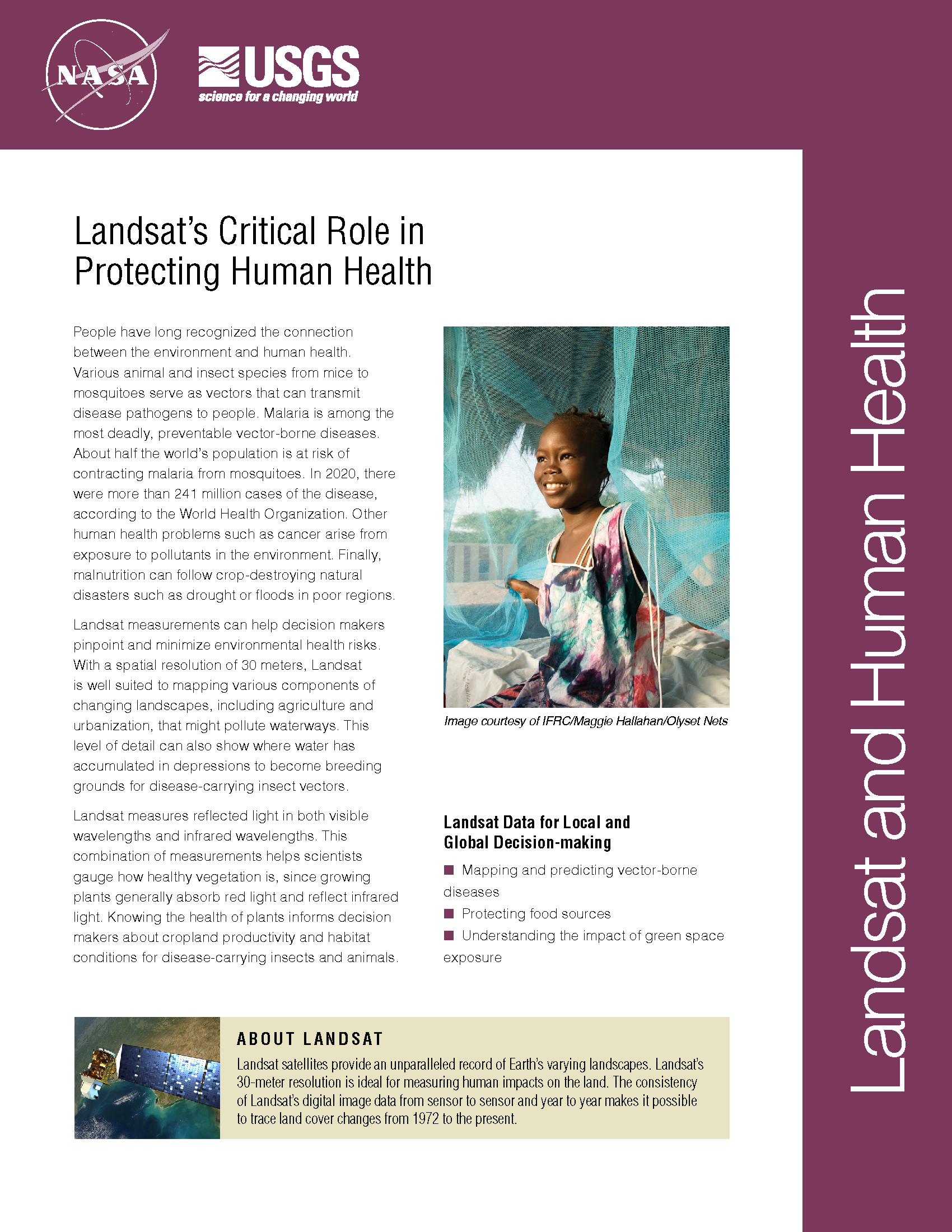Landsat’s Role in Protecting Human Health
People have long recognized the connection between the environment and human health. Various animal and insect species from mice to mosquitoes serve as vectors that can transmit disease pathogens to people. Malaria is among the most deadly, preventable vector-borne diseases. About half of the world’s population (3.3 billion people) is at risk of contracting malaria from mosquitoes, according to the World Health Organization. Other human health problems such as cancer arise from exposure to pollutants in the environment. Finally, malnutrition can follow crop-destroying natural disasters such as drought or floods in poor regions. Landsat measurements can help decision makers pinpoint and minimize environmental health risks. With a spatial resolution of 30 meters, Landsat is well suited to mapping various components of changing landscapes, including agriculture and urbanization, that might pollute waterways. This level of detail can also show where water has accumulated in depressions to become breeding grounds for disease-carrying insect vectors. Landsat measures reflected light in both visible wavelengths and infrared wavelengths. This combination of measurements helps scientists gauge how healthy vegetation is, since growing plants generally absorb red light and reflect infrared light. Knowing the health of plants informs decision makers about cropland productivity and habitat conditions for disease-carrying insects and animals.
Managing Water in Conflict-Torn Regions
Understanding the relationship between land use and river flows in the Yarmouk basin.
Land Cover Matters: An Avian Flu Researcher Talks Landsat
We recently spoke with veterinary epidemiologist Todd Kelman from the University of Davis, California about his avian flu research. Todd has incorporated Landsat data into his research and we wanted to know more.
A Real-Life Bay Watch: NASA Helps Monitor LA Coastline
When a Los Angeles water treatment plant had to discharge treated water closer to shore than usual in the fall of 2015 due to repair work, NASA satellite observations helped scientists from the City of Los Angeles and local research institutions monitor the Santa Monica Bay for any impacts. For the city, it was an opportunity to assess the use of satellites in guiding a substantial monitoring effort. For NASA, it was an opportunity to refine the use of satellite assets to study a coastal environment.

Future Grains
When global food prices spiked dramatically in late 2007 and into 2008, the costs of many basic dietary staples doubled or even tripled around the world, sparking protests and riots. Panicked governments stopped exporting food, aggravating the crisis.
Monitoring Small Surface Water Bodies in Africa
Naga Manohar Velpuri, works with the USGS Famine Early Warning Systems Network (FEWS NET). The project has recently initiated a large-scale project to monitor surface water bodies in the pastoral regions of Africa using multi-source satellite data and hydrologic modeling techniques. Currently, a total of 293 water points are being monitored in 10 countries. Velpuri shared some of the projects findings he presented at #AGU15.
Detecting Landslides in Nepal with Landsat
Justin Roberts-Pierel from the Joint Center for Earth Systems Technology, uses Landsat 8 to detect landslides in the Himalayas. He provided information about his studies at #AGU15. We talked with him about his work.


